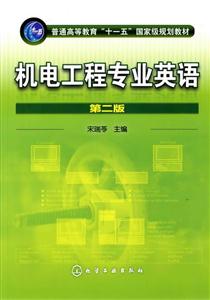-
>
西班牙语词根宝典
-
>
英语大书虫世界经典名译典藏书系:中国人的精神 (英汉对照)(精选权威版本)
-
>
许渊冲译唐诗三百首:汉文·英语
-
>
四级词汇词根+联想记忆法:乱序版
-
>
The secret garden
-
>
英国文学名篇选注
-
>
许渊冲译千家诗
机电工程专业英语-第二版 版权信息
- ISBN:9787122085672
- 条形码:9787122085672 ; 978-7-122-08567-2
- 装帧:暂无
- 册数:暂无
- 重量:暂无
- 所属分类:>>
机电工程专业英语-第二版 本书特色
《机电工程专业英语(第2版)》:普通高等教育“十一五”国家级规划教材
机电工程专业英语-第二版 内容简介
本书共分为8章,内容包括制造导论、机械工程基础、机械制造技术、电子及控制技术、数控技术、数控操作、现代制造技术、现代管理和互联网及应用等,每章含有课文正文、生词词组、难点注释、理解练习、阅读材料等部分,各章节内容上彼此独立,难度上循序渐进。
本书内容新颖,覆盖面广,且有一定的专业针对性和实用性。
本书的教学资料:包括ppt教学课件,词汇测试系统等,是教师教学和学生学习的好帮手,并将免费提供给采用本书作为教材的院校使用。如有需要,请发电子邮件至cipedu@163.com 获取,或登录www.cipedu.com.cn免费下载。
本书可作为高职高专机械、机电、数控、工业工程及相关专业的教材,也可供工程技术人员参考。
机电工程专业英语-第二版 目录
lesson 1 properties of materials
reading metals and alloys
lesson 2 classification of steels
reading machinability of metals
lesson 3 heat treatment
reading materials used for shafting
lesson 4 types of gear
reading cams
lesson 5 rolling-type (antifriction) bearings
reading clutch, rack and worm
chapter two technique of manufacturing engineering
lesson 1 mechanism of chip formation
reading cutting fluids and their importance
lesson 2 engine lathe
reading lathe work
lesson 3 the hydraulic system
reading hydraulic pumps
lesson 4 electric discharge machining
reading laser beam machining
lesson 5 benefits of a quality system
reading introduction to iso 9000 basics
chapter three electronics technology and automation
lesson 1 types of integrated circuits
reading optoelectronics
lesson 2 printed circuit
reading repair of printed circuit
lesson 3 alternating-current motors
reading motor& motor care and maintenance
lesson 4 interfacing
reading a/d&d/a converter
lesson 5 controllers
reading guidelines for designing a plc system
chapter four cnc machines
lesson 1 the fundamentals of cnc
reading the concepts of computer numerical control
lesson 2 types of cnc machines
reading laser cutting
lesson 3 the cnc control
reading components of cnc machine
lesson 4 methods for cnc programming
reading manual programming
lesson 5 cad/cam
reading cad/ cam integration
chapter five cnc machine operating
lesson 1 explanation of the keyboard
reading fanuc—besk nc system
lesson 2 tilting nc-rotary table
reading employment opportunities in nc
lesson 3 handling and operation
reading chart
lesson 4 failures and breakdowns
reading position detectors- opto-electronical rotary encoders
lesson 5 service and maintenance
reading error search and repair
chapter six modern manufacturing technology
lesson 1 flexible manufacturing systems
reading robotics
lesson 2 expert systems
reading decision support systems
lesson 3 computer aided process planning
reading artificial intelligence & expert system
lesson 4 rapid prototyping and freeform fabrication
reading stereolithography
lesson 5 from the present to the future
reading aesthetics in design
chapter seven modern management
chapter eight computer and application
references
机电工程专业英语-第二版 节选
《机电工程专业英语(第2版)》共分为8章,内容包括制造导论、机械工程基础、机械制造技术、电子及控制技术、数控技术、数控操作、现代制造技术、现代管理和互联网及应用等,每章含有课文正文、生词词组、难点注释、理解练习、阅读材料等部分,各章节内容上彼此独立,难度上循序渐进。 《机电工程专业英语(第2版)》内容新颖,覆盖面广,且有一定的专业针对性和实用性。 《机电工程专业英语(第2版)》可作为高职高专机械、机电、数控、工业工程及相关专业的教材,也可供工程技术人员参考。
机电工程专业英语-第二版 相关资料
插图:Thus the cooling properties of cutting fluid depend to a large extent on thecooling method. The cooling efficiency increases with heat conductivity and specificheat of the cutting fluid, with its heat of fusion and of vaporization, and also with itsviscosity. Cooling effect increases, too, with the flow rate of the fluid, the area ofapplication and with decreasing temperature of the cutting fluid.The lubricating action of the cutting fluid reduces the external friction betweenrake face and chip and between flank and machined surface~. Effectiveness of thelubricating action depends, therefore, in the first place on the degree of penetration ofthe coolant between those surfaces. It follows from the magnitude of specific cuttingforces that very often, i.e. when machining steel, pressures between chip and toolpoint and between workpiece and tool point may reach 20000~30000 kg/cm2. Notwithstanding such high pressures, the use of suitable cutting fluids results in thereduction of friction and wear.The washing action of a cutting fluid consists in removing the products ofabrasion, chip fragments and tool wear particle. In practice, cutting fluids exhibitgood washing properties having high wettability and because particles immersed inthe liquid move downstream.This action has an advantageous influence on the smoothness of the machinedsurface and on the reduction of tool point wear.Surface loosening action of the cutting fluid, also called the cutting action of thisfluid, results from the so-called Rebinder effect. Adsorbed molecules of cutting fluid,particularly of liquids containing surface-active additives, disintegrate, diffuse andpenetrate into microgaps resulting from defects in the crystal lattice. Because of thewedge-like action of the adsorbed liquid, a very thin surface layer of the machinedmaterial becomes "loosened".According to Rebinder's research, the thickness of this layer may reach 0.1 mm.Since the machined surface in the next pass becomes the work surface, plasticdeformation appearing in the chip formation area and slip of the chip elements occurmore easily and more frequently. This phenomenon is called internal lubrication.The efficiency of activated liquids increases with a reduction in unreformedchip thickness, since in this case the percentage share of the thickness of loosed layer is greater in relation to the total thickness.Increasing the cutting speed decreases the efficiency of activated liquids. This is due to a more ductile chip, having a much smaller number of larger gaps of all sorts (lack of preceding gap and of built-up edge). Consequently, much fewer local vacuum spots are formed and the liquid does not penetrate everywhere, and dry friction may result.
- >
二体千字文
二体千字文
¥22.4¥40.0 - >
姑妈的宝刀
姑妈的宝刀
¥9.0¥30.0 - >
小考拉的故事-套装共3册
小考拉的故事-套装共3册
¥36.7¥68.0 - >
我与地坛
我与地坛
¥16.5¥28.0 - >
莉莉和章鱼
莉莉和章鱼
¥13.4¥42.0 - >
推拿
推拿
¥12.2¥32.0 - >
史学评论
史学评论
¥22.7¥42.0 - >
苦雨斋序跋文-周作人自编集
苦雨斋序跋文-周作人自编集
¥5.8¥16.0
-
4.23文创礼盒A款--“作家言我精神状态”
¥42.3¥206 -
4.23文创礼盒B款--“作家言我精神状态”
¥42.3¥206 -
一句顶一万句 (印签版)
¥40.4¥68 -
百年书评史散论
¥14.9¥38 -
1980年代:小说六记
¥52.8¥69 -
中图网经典初版本封面-“老人与海”冰箱贴
¥20¥40





















